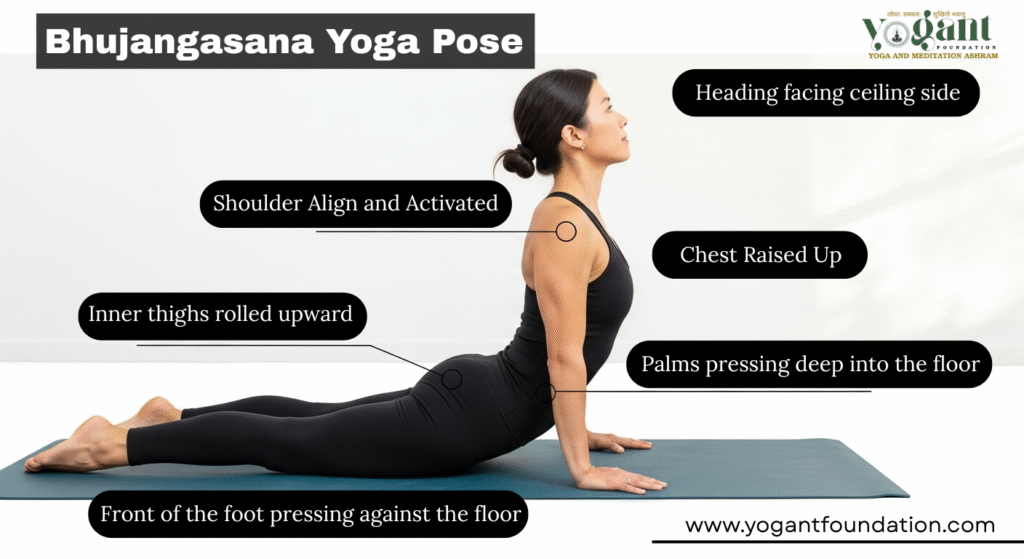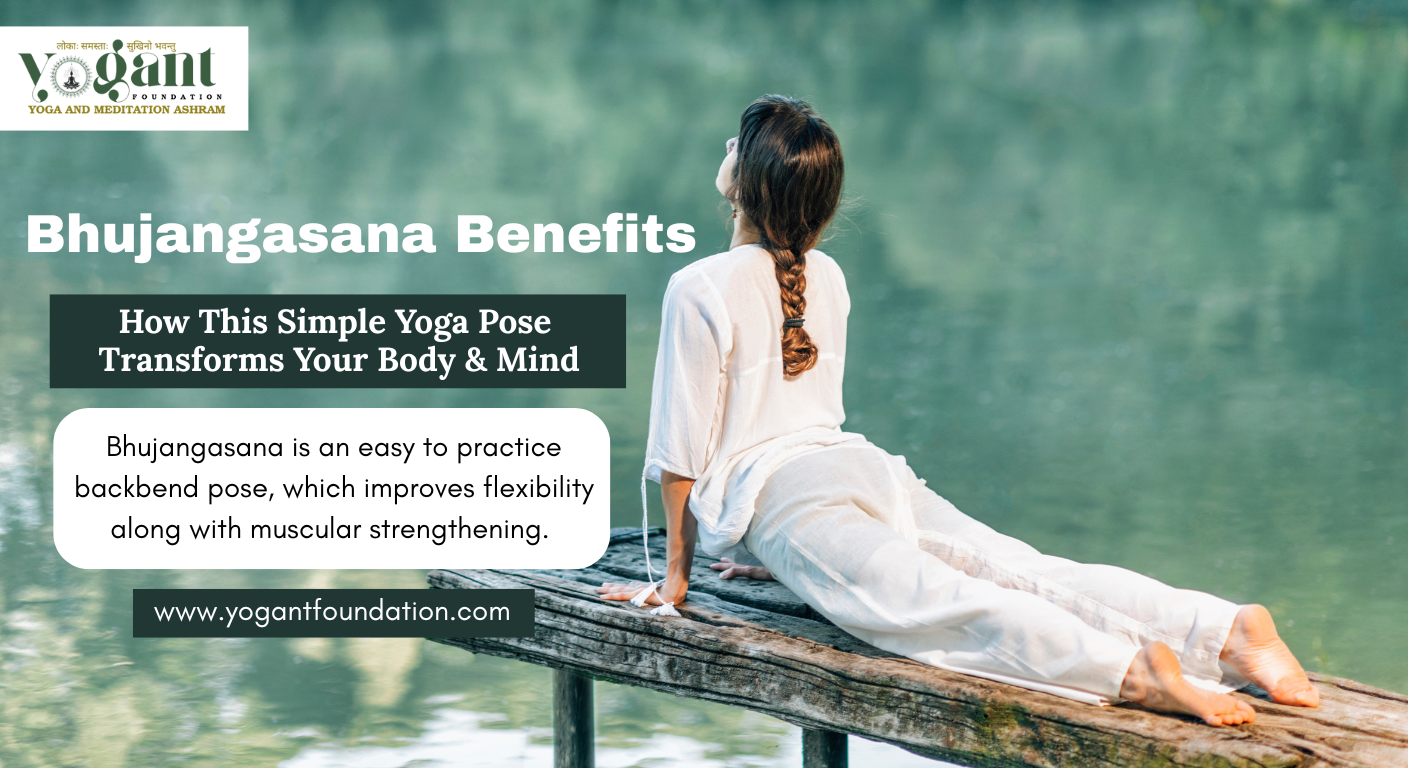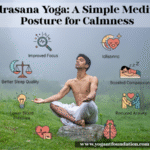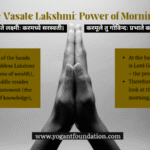Introduction
Asanas are just one part of Yoga. It also includes breath control (pranayama), mindfulness, and transformation. Bhujangasana – the Cobra Pose – is a favorite among its many poses. The Cobra Pose is graceful (for most), accessible, powerful, and a symbol. Bhujangasana, like a snake lifting its head to reveal its strength, helps lift our chests, opens the heart, and increases spinal flexibility.
We will be exploring:
- Meaning and history of Bhujangasana
- How to follow step-by-step instructions
- Changes and modifications
- The benefits (physical, mental, and energetic)
- Warnings and Contraindications
- Safe and Effective Practice Tips
- Bhujangasana: How to incorporate this pose into daily yoga practice
- Yoga sequencing ideas
- Commonly asked questions
- Last thoughts
This comprehensive article, which is SEO-aware, is meant to help beginners as well as intermediate practitioners learn and apply Bhujangasana.
What Is Bhujangasana? (Etymology & Origins)
Meaning & Sanskrit Roots
- Bhujangasana derives from Sanskrit roots, Bhujanga meaning “snake”, and asana meaning “posture”, as well as “seat”.
- In the full pose, the body mimics that of a cobra by raising the head and hood.
- Cobra Pose is also called Cobra Pose, or “cobra” in Western Yoga traditions.
Historical & Yoga Tradition Context
- Bhujangasana (reclining backbend) is an important posture in Hatha Yoga as well as modern yoga.
- This backbend is commonly included in the sequence Surya Namaskar (Sun Salutation), in various styles.
- Hatha yoga is also described as a posture in classic texts of Yoga (for instance, Gheranda Sahita).
Bhujangasana belongs to an ancient lineage of yoga poses, but is still widely used today by many styles, including Ashtanga and Vinyasa yoga. ).
How to do Bhujangasana – Step by step
The following is a structured, safe method for doing Bhujangasana. Listen to your body, follow the instructions carefully, and listen.
Preparation & Setup
- Select a quiet, comfortable surface. Use a yoga mat or cushioned floor.
- Do some gentle spine flexion/extension before you begin. Gentle twists (Cat-Cow), or the child’s posture, can also help.
- Lie prone (face down).
- The legs should be straight and the toes facing back.
- Your comfort level and hip mobility will determine whether your feet are together or slightly separated.
- Rest your head on the mat at first.
Step-by-Step Entry
- Hands Placement
- With fingers open, bring your hands down on your mat and gently place them under your shoulders.
- Your elbows must be bent so that they brush your ribs, and not flare out wide.
- The lower body
- The pubic bone or lower abdomen should be pressed firmly against the floor.
- The legs, tops, and thighs of your feet must remain grounded, active, (engaged.
- Initial Lift
- When you inhale using your back muscles, begin lifting your chest. Keep the elbows first bent.
- As you roll your shoulders, open your chest.
- You want your elbows to hug against your ribs. Do not spread your arms outward.
- Expand gradually
- Only lift your arms to the extent that you are comfortable.
- Pushing with your arms is not recommended. Instead, use your back muscles to help lift.
- Maintain the anchoring of the pelvis and do not overarch the lower back. Spread the bend.
- Avoid straining your neck.
- Hold the pose
- You can breathe here from 5- 20 times (or more), depending on how flexible, strong, and experienced you are.
- Maintain a straight spine and keep breathing.
- Leave the pose (fall)
- When you exhale slowly, be mindful when doing so.
- First, lower your chest and head.
- Rest your head to one side and take a few breaths.
The Alignment Guide
- Concentrate on lengthening the spine rather than compressing.
- Arches should be even and smooth, without any pinched areas.
- Protect the spine by gently engaging the core muscle and the abdominal muscles.
- Stabilize the hips by pressing through the rear of your legs.
- The front of the body will be opened by gently drawing the shoulder blades toward the spine.
- Lift from your chest instead of using your hands to thrust.
Alterations and Modifications
You can modify and vary the full Bhujangasana if it is too difficult or intense for you.
- Baby Cobra – Lift your upper back only by lifting your elbows.
- Cobra Supported – Place a blanket, or even a bolster, beneath the hips.
- Rest your hands on your elbows – Instead of pressing your palms together, you can rest your hands on your elbows.
- Cobra lifted with only one leg– Lift the other leg and hold on to the Cobra for a balance challenge.
- The Sphinx Pose- This version is more gentle: Forearms to the floor and elbows under the shoulders.
- Props or walls – You can use blocks to reduce the depth of a backbend by practicing it against a brick wall.
Benefits of Bhujangasana
Bhujangasana, a powerful pose in yoga, offers many health benefits, including energy, mental, and physical. The following is a discussion and a classification.
Physical & Physiological Health Benefits
Strengthens the spine and muscles of the back
- The erector spinae, the multifidus muscles, and other surrounding muscles can be strengthened by regular cobra practices.
- The product promotes spinal health, and it helps those with sedentary habits counterbalance the spinal compression.
Enhances the flexibility of the spine
- This backbend promotes mobility of the vertebral column by gently extending it.
- It is beneficial to stretch the muscles and ligaments of the back, as well as the intervertebral region.
Opening the shoulders and chest
- The thoracic cavity is expanded, increasing lung capacity.
- Stretches the anterior shoulder, pectorals, deltoids, and trapezius.
Stimulates abdominal organs & digestion
- As the viscera of the abdomen are alternately stretched and compressed, digestion can improve.
- This pose is great for constipation, as it massages the organs.
Tighten the glutes, buttocks
- Stabilizing the hips requires a slight engagement of the gluteal muscle.
Enhances circulation and revitalizes the entire body
- Increased blood flow to the spine and abdomen
- This mild lifting of the chest in an inverted position can encourage venous returns and boost energy.
Reduces fatigue & back pain
- If you have mild lower back pain, this is a good way to reduce it.
- This exercise helps reduce stiffness and fatigue by opening the chest.
Position correction
- Sitting and using electronic devices can lead to a slumped posture. Bhujangasana helps to counteract this posture by stretching the spine and opening your front body.
- The squat helps improve forward-headed posture, rounded shoulders, and the stance of the head.

Emotional, Mental & Energy Benefits
- Helps reduce stress, mild depression, and anxiety
- Mental tension can be eased by opening up your heart, stretching out your spine, and using conscious breathing.
- Some small studies on yoga programs, such as Cobra, have demonstrated improvement in mild symptoms of depression.
- Improves confidence, energy & mood
- Opening with a gentle upwards movement tends towards eliciting a positive emotional response — similar to the feeling of reclaiming expansiveness.
- A heart-opening pose is often used in yoga to symbolize letting go.
- Balancing the energy channels of Nadis (Chakras),
- According to yogic practices, backbends help activate Sushumna Nadi and “unstick energy flows”.
- Certain lineages also consider it beneficial for the Heart Chakra and, Throat Chakra.
- Openness and surrender are encouraged by the stretch of the front body.
- Mental-body awareness and concentration
- By maintaining internal awareness, breathing, and sensation, you can improve your concentration and sharpen your inner awareness.
Warnings & Contraindications
Bhujangasana can be practiced widely, but some health concerns should not be ignored. When in doubt, consult with a qualified yoga teacher or a health professional.
What to avoid or modify
- If you are pregnant or have had abdominal surgery recently– avoid backbends that are too deep or make modifications to your posture.
- Serious lower back injury or herniated disks– Only practice with guidance, or avoid deep versions.
- Carpal-tunnel syndrome and wrist injuries – pressure to the palms can exacerbate wrist conditions.
- Neck or cervical spine issues– Avoid head extensions and keep your gaze minimal or neutral.
- Recent abdominal surgeries, hernia, ulcer– avoid deep compression.
- If you have severe osteoporosis, backbends might be contraindicated.
- Migraine, headache, or high blood pressure (uncontrolled)– If you suffer from migraines, headaches, or uncontrolled high blood pressure, consult an expert before proceeding.
- Stop immediately– if you experience any discomfort while performing.
Tips and Warnings
- Don’t force your spine into a painful arch. Instead, only go to the limits of your ability.
- Avoid collapsing your lumbar spine by distributing the bend.
- To protect your lower back, use core engagement.
- Do not jerk the neck.
- Before attempting more advanced variations, warm up.
- Props can be used (blankets and bolsters), if necessary.
- When you experience sharp pain, burning, or pins-and-needles, stop immediately.
Tips for a Safe & Effective Practice
- Don’t hold your breath. Inhale and exhale slowly. Smooth, even inhales are best.
- When you are new, start small. Concentrate on a low cobra height first and then increase it gradually.
- Consistency is key. Daily practice, no matter how short it may be, will yield better results.
- Use mirror or video feedback. Test alignment using a video or a mirror.
- Focus on the mid-back (thoracic) engagement. Do not overbend your lower back. Instead, focus on engaging the mid back.
- A warm-up can help to prepare your spine. Cat-cow, spinal flexion, and gentle twists are all helpful.
- Inverses. Follow up your spinal neutralization with a forward bend.
- Avoid overdoing it. At first, try holding for fewer breaths.
- If needed, try using variations or props like a cover under the pelvis.
- Be mindful over ego. Don’t compare your depth to others.
How to Incorporate Bhujangasana into Your Practice / Routine
In Daily Yoga Practice
Bhujangasana is easy to include in any practice:
- In Surya Namaskar / Sun Salutations– often used to backbend the Chaturanga pose or as Upward Dog.
- As part of a backbend sequence– for example, Begin with the low Cobra. Next, bridge.
- As a standalone posture– alternate 2-5 cobra rounds with rest and child’s posture.
- Pre-or post-meditation / pranayama that helps open chest, prepare breathing.
Sample Short Sequence (15 minutes)
- Centering + gentle stretches (neck, wrists)
- Cat-Cow (5 rounds)
- Child’s Pose
- Bhujangasana (2-3 rounds, modest height)
- Upward Dog
- Low Back Twist (Lying)
- Seated Forward Bend / Sitting posture
- Savasana
Sample Longer Flow (45 min)
- Warm-up: Sun Salutations (5 rounds),
- The dynamic cobra flow – a link between variations and transitions
- The backbends of the bridge and wheels are deeper
- Folds and twists
- The seated meditation/pranayama
You can change the number of Cobra rounds according to your strength, flexibility, and time.
Commonly Asked Questions (FAQs).
Q1 How long should I do Bhujangasana for beginners?
Five to ten breaths are sufficient. You can hold the position for up to 30 breaths, or longer, if you are comfortable.
Q2 Should I lift my arms or back muscles to raise myself?
Hands should support the muscles of the back. Overpressing the arms can cause wrist and spine compression.
Q3 Is it possible to perform Bhujangasana if you have lower back pain?
Possibly. But proceed with caution. Begin with very low lifts and keep your spine protected. If pain worsens, stop. If pain worsens, stop.
Q4: Cobra or Upward-Facing Dog? Which is the better choice?
The two have their benefits. Cobra has a gentler feel (feet stay on the ground and pelvis stays firmly planted). Upward Dog has more intensity (legs raise, arm strength increases). Cobra should be used when you are warming up, or with caution if your lower back is affected.
Q5 How often should you practice Bhujangasana?
Even if you only play a few rounds, it is best to play at least one round a day. Consistency is more important than depth.
Q6: Can children practice Bhujangasana?
You can, but only under supervision. Use gentler variations, focus on alignment, and avoid pushing too deeply.
Q7. Does Bhujangasana promote weight loss and fat loss?
Bhujangasana may not be a pose that will burn a large number of calories, but it is a good posture for supporting metabolism, core involvement, and flexibility. When combined with holistic exercises, it can contribute to a healthy body. Some sources suggest that Cobra poses can tone the abdominal area and boost metabolism.



